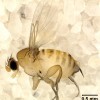Abstract
The zombie fly is primarily a parasitoid of bumble bees and wasps in North America. In 2012, Dr. John Hafernik and his colleagus at San Francisco State University discovered that Apocephalus borealis also parasitizes honey bees. Parasitized honey bees show zombie-like behavior by leaving their hives at night and are often attracted to nearby lights where they show disoriented behavior and die in a few hours. This 5-page fact sheet was written by Nicole A. Casuso, Ashley N. Mortensen, and James D. Ellis, and published by the UF Department of Entomology and Nematology, October 2014. (Photo: Jessica Andrieux, CC SA-BY 2.5)
References
Brues CT. 1924. Notes on Some New England Phoridae (Diptera). Psyche 31: 41-44. doi:10.1155/1924/42175. https://doi.org/10.1155/1924/42175
Collins L, Scheffrahn RH. Solenopsis invicta Buren (Insecta: Hymenoptera: Formicidae: Myrmicinae). (2013). EENY 195. Gainesville: University of Florida Institute of Food and Agricultural Sciences. [http://entnemdept.ufl.edu/creatures/urban/ants/red_imported_fire_ant.htm] (24 September 2014).
Core A, Runcke C, Ivers J, Quock C, Siapno T, DeNault S, Brown B, DeRisi J, Smith CD, Hafernik J. 2012. A new threat to honey bees, the parasitic phorid fly Apocephalus borealis. PLoS ONE 7 (1): e29639. doi:10.1371/journal.pone.0029639. https://doi.org/10.1371/journal.pone.0029639
Hafernick J. Flight of the Living Dead. TEDx Talk. (2012). https://www.youtube.com/watch?v=BWl_1vrSxMc (19 August 2013).
Ennik F. 1973. Apocephalus borealis Brues parasitic upon Vespula spp. (Diptera: Phoridae, Hymenoptera: Vespidae). Pan-Pacific Entomologist 49: 403-404.
Mortensen AN, Schmehl DR, Ellis JD. (2013) Apis mellifera Linnaeus, and subspecies (Insecta: Hymenoptera: Apidae). EENY 568. Gainesville: University of Florida Institute of Food and Agricultural Sciences. http://entnemdept.ufl.edu/creatures/MISC/BEES/euro_honey_bee.htm (24 September 2014).
Otterstatter MC, Whidden TL, Owen RE. 2002. Contrasting frequencies of parasitism and host mortality among phorid and conopid parasitoids of bumble-bees. Ecological Entomology 27(2): 229-237. https://doi.org/10.1046/j.1365-2311.2002.00403.x
Ravoet J, Maharramov J, Meeus I, De Smet L, Wenseleers T, Smagghe G, de Graaf DC. 2013. Comprehensive bee pathogen screening in Belgium reveals Crithidia mellificae as a new contributory factor to winter mortality. PLoS ONE 8(8): e72443. doi:10.1371/journal.pone.0072443 https://doi.org/10.1371/journal.pone.0072443
Smith K, Loh E, Rostal M, Zambrana-Torrelio C, Mendiola L, Daszak P. 2013. Pathogens, pests, and economics: drivers of honey bee colony declines and losses. EcoHealth 10: 434-445. https://doi.org/10.1007/s10393-013-0870-2
Stange LA, Fasulo TR. (1998) Bombus spp. (Insecta: Hymenoptera: Apidae). EENY-50. Gainesville: University of Florida Institute of Food and Agricultural Sciences. [http://entnemdept.ufl.edu/creatures/misc/bees/bumble_bees.htm] (24 September 2014).

